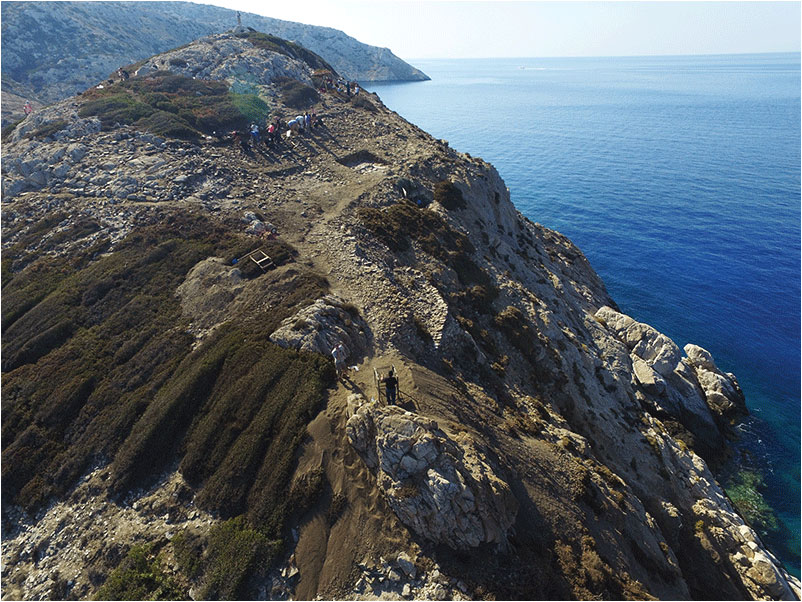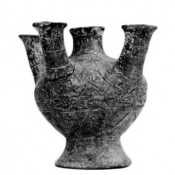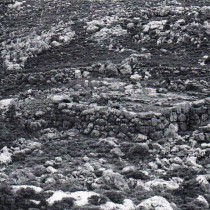During September and October of 2018 the fourth and final field season of the project Sea Routes of Keros and Naxos was conducted by the University of Cambridge under the auspices of the British School at Athens and supervised by the Cyclades Ephorate of Antiquities. The project was headed by Professor Colin Renfrew, Dr Michael Boyd and with Irene Legaki from the Cyclades Ephorate of Antiquities acting as deputy head.
The four year project (2015-2018) was a continuation of the excavations conducted from 2006 to 2008 at the Kavos site, Dhaskalio, on the west tip of Keros, headed by Professor Colin Renfrew of Cambridge University and Dr O.Filaniotou of the Cyclades Antiquities Ephorate. Excavations were also carried out by the Archaeological Service in 1963 and 1967 under Professor Christos Doumas and Dr Fotini Zaphiropoulou respectively. While surveying the site, large quantities of pottery had been located. As already seen in the 1987 and 1988 surveys by the Inter-University Project of the Universities of Athens, Ioannina and Cambridge in collaboration with the Cyclades Ephorate of Antiquities, this pottery had been ritually deposited in two ‟Special Depositors” over a period of about five hundred years (2750-2240 BC) indicating, according to Professor Renfrew, the earliest island sanctuary in the world. Some of the sculptures originally had a height of up to one meter, while according to the same interpretation the material had been intentionally broken into pieces on other islands of the Cycladic archipelago and then taken to Kavos to be ritually deposited.
As part of the recent project completed last autumn, excavations were carried out on the small island of Dhaskalio, originally connected by a narrow strip of land to the adjacent site of Kavos, where an extremely important settlement was located which, according also to radiometric dating, flourished during the Early Bronze Age. To date, excavations have brought to light a series of impressive stairways, drainage pipes and stone structures that reveal an advanced urban architecture unlike any other of that particular period.
This year’s finds have deepened our knowledge of the Dhaskalio settlement. A steep path led to the latter’s top, across extended flat terraces created to allow for suitable building space. The complicated, interconnected and multiple level architecture speaks of the existence of a well organized and well built settlement on a steep peninsula. Most of the buildings at Dhaskalio were built of good quality marble coming from nearby Naxos (10 km north), since Keros itself had no such stone. According to Professor Renfrew, the excavation’s co director, a series of advanced architectural techniques can be observed on Dhaskalio that were used in a well organized manner. This is made evident by huge entrances, stone stairways and an intricate system of drainage pipes that cover the entire island. According to this interpretation, the above seem to suggest the existence of an expert architect as well as a central mechanism for the design and implementation of a building program that can only be compared to that of Knossos on Crete during the same period.
The importing of marble from Naxos is just one indication of the seafaring skills of Dhaskalio’s inhabitants. Moreover, the many tools of obsidian; volcanic glass brought from Milos, confirm that the islanders were great sailors. All the shards of pottery that were found (a total of 101.313) were also imported, pointing towards a huge maritime network extending across the entire Cycladic archipelago and beyond. But perhaps the most remarkable import of all was the raw material for metalworking. Among the most important finds this year were the facilities for the casting of bronze artefacts, such as axes, chisels and fibulae, as well as spear heads and daggers. Traces of slag found on pottery shards in many parts of the site confirm that metal work was taking place in a number of spots of the settlement. Dr Michael Boyd, the excavation’s co director, notes that one of this site’s unique features was the metαl work that seems to have played an important role throughout the settlement’s entire life. It is one of the most recognizable activities on the site, observed in all the places excavated. Metal work on such a scale presupposes a continuous supply of raw materials from the western Cyclades or from Attica, as well as social structures that allow the learning and preservation of technical skills. But the most important question, according to Dr Boyd, is where the final product ended up, and in this sense it seems likely that the reason for the existence of the maritime networks with Dhaskalio as the the focal point was the exchange of metal objects such as daggers for example.
The closest location with significant rural dynamics is Kato Koufonisi, which is about 5 km northwest of Keros, and was a station on the route to the much bigger and agriculturally richer island of Naxos. During this year’s research season (September3- October13), a surface survey was conducted in Kato Koufonisi under Dr. George Gavalas of the Cyclades Ephorate of Antiquities and Professors Jill Hilditch and Joshua Wright from the Universities of Amsterdam and Aberdeen respectively.
Based on surface markings and pottery, we are now able to recognize traces of habitation from different periods. In the southern part of the island is the site of an Early Bronze Age settlement closest to Dhaskalio. According to the research team, Kato Koufonisi was of equal importance to Dhaskalio as was Keros itself.
After the completion of the surface survey, a trial excavation was repeated at the Polygon 4 in Keros, about 300 m north of Kavos Dhaskalio, under Dr. George Gavalas of the Cyclades Ephorate of Antiquities. The trial trench opened in 2017 was extended to investigate how three rough walls were connected and to complete checking the methodology of the surface survey conducted in 2012-2013 in Polygons 2 and 4, in collaboration with the Archaeological Service and the British School at Athens, under Dr. M. Marthari, Dr Aikaterini Dellaporta, Professor C. Renfrew and others. The material found during this year’s excavation survey at Polygon 4 was dated to the Proto Cycladic era, while samples were taken for Optically Stimulated Luminescence dating (OSL).
The use of new technologies have been at the heart of the project, offering not only new directions for research but also providing quicker analyses results. . A series of environmental studies, from the identification of burned seeds and charcoal to the identification of microscopic plant remains (phytoliths) and traces of animal and plant lipids and starches in pottery shards and stone tools, have led to a new understanding of the region’s rural economy and environment. Dr Evi Margariti of the Institute of Cyprus, head researcher on organic residues at Dhaskalio and deputy director of the project, says that Keros alone could not maintain a prosperous site like Dhaskalio. All available data has shown that many of the foods for local consumption were imported. This implies the existence of a region for agricultural production that extended to the neighboring islands, which is further evidence of Dhaskalio having being the largest settlement by far in the greater area.
During this year’s excavations, the Cyprus Institute organized for the third year running a related training program in cooperation with the University of Cambridge. Students from Greece, Australia, New Zealand, the USA, Canada and the United Kingdom participated in the excavation. The Cyprus Institute also participated in the 3D depiction and reconstruction of the site through virtual reality.
According to the excavators, surveys on Dhaskalio have solved the enigma of the extensive illegal excavations conducted prior to 1963 at Kavos on Keros, since the first organized archaeological excavations in the area showed that the recovered fragmented material had been dug up illicitly. Today, the nature of the Kavos sanctuary on Keros has become clearer, with the thorough examination of the nearby settlement of Dhaskalio completed. It can now be argued that this particular site was an important regional center for all the Cyclades.
Project details
The project was under the auspices of the British School at Athens and realized under the authority of the Ministry of Culture and Sports, supported by Dimitris Athanasoulis, Director of the Cyclades Ephorate of Antiquities and supervised by Stefanos Keramis the archaeologist responsible for the region. The project was headed by Colin Renfrew and Michael Boyd of the McDonald Institute for Archaeological Research, University of Cambridge. Irene Legaki of the Cyclades Ephorate of Antiquities was Deputy Director. George Gavalas of the Cyclades Ephorate of Antiquities, Evi Margariti, Jill Hilditch and Josh Wright were deputy heads. Ioanna Moutafi was Archaeological Field Director. The project was supported by the following bodies: The Institute for Aegean Prehistory, the A.G Leventis Foundation, the Stavros Niarchos Foundation, the Cyprus Institute, the McDonald Institute for Archaeological Research, the Research Promotion Foundation, the British Academy, the Society of Antiquaries of London, Gerda Henkel Stiftung, the National Geographic Society, Cosmote, Blue Star Lines and EZ-dot.





